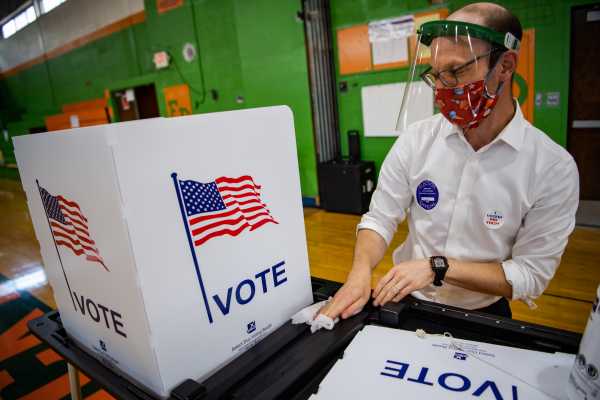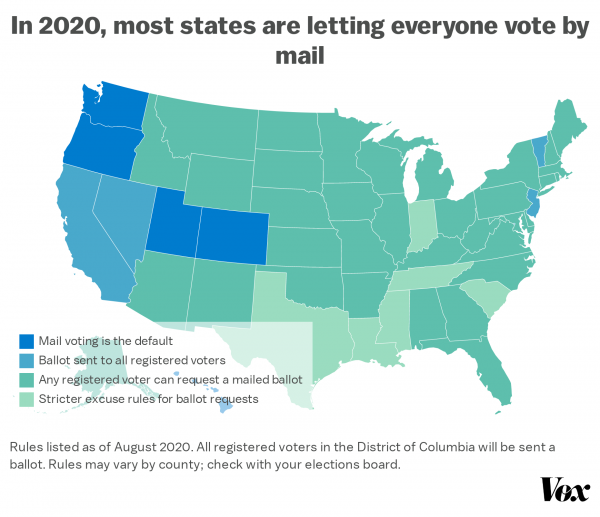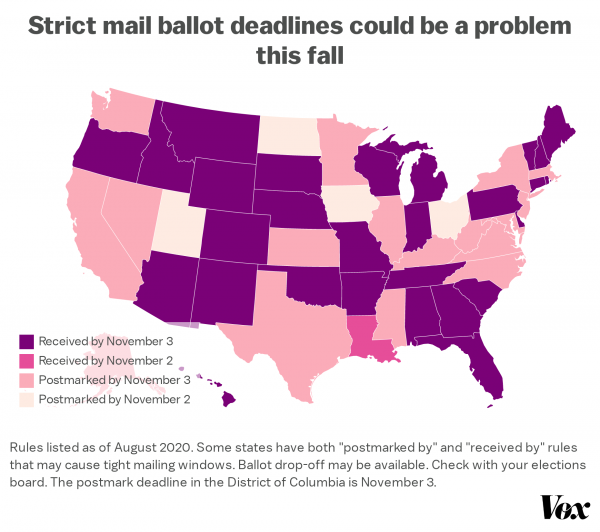
This story is part of a group of stories called

Vox answers your biggest questions about the 2020 US presidential election, which could be one of the most consequential of our lifetimes.
The presidential election is 50 days away, and here’s what America is dealing with: a raging pandemic, a crisis at the United States Postal Service, the threat of foreign meddling, and lots of misinformation, including from the president’s Twitter account.
All of this raises a serious question: How can you make sure your vote will count in 2020?
Voting in the middle of a pandemic was always going to look different. For those who choose to vote in person, voters and poll workers will likely have to social distance and wear masks. A lot of people might forgo in-person voting altogether; the number of Americans voting by mail is expected to double compared to 2016.
And then came the controversy at the United States Postal Service. A series of cost-cutting measures sparked delays in mail delivery, which critics feared could undermine the USPS’s ability to sort and deliver ballots in time to be counted, potentially disenfranchising millions of voters. The USPS has since suspended these changes, and Postmaster General Louis DeJoy assured lawmakers in August that the November election is his “number one priority.”
But primary season amid the Covid-19 pandemic didn’t exactly go smoothly. The Washington Post reported that some half a million mail-in ballots were rejected in the primaries, a combination of late delivery and voter error.
All this is eroding faith in the exercise of democracy this November — and, potentially, in the election results themselves.
The United States’ voting system had significant problems before the pandemic and will after, unless there’s reform. There should be. But that’s not going to happen in time for November 3. Indeed, many states will start mailing out ballots in just a few weeks.
So here’s a guide on how voters can better navigate the election and, in the process, make the voting system better for everyone. The biggest takeaway: Don’t wait.
“If you do you want to simplify it down to the easiest thing, it’s two words: Plan early,” David Becker, executive director and founder of the Center for Innovation & Election Research, told me. “That’s it, that’s everything.”
Make a plan, and do it early
There’s been a lot of talk about making a “voting plan.”
“Make a plan right now for how you are going to get involved and vote,” former President Barack Obama said during his address at the Democratic National Convention. “Do it as early as you can, and tell your family and friends how they can vote, too.”
There is one guiding principle to this plan, and you have maybe guessed it: Do everything — everything, everything, everything — early.
The very first step is the most critical: Make sure you can vote. Find out if you are registered. Even if you think you are, you can double-check and make sure your information is up to date. Do this now at your state or local election website, which you can look up here.
Seriously, do it now, we’ll wait.
(Note: We’ve included some voting rules maps below, but the rules can change. The best way to find information and deadlines for voting is with your state or local election board, which, again, you can track down here.)
Since you’re now hanging out on the web page belonging to your area’s election officials, it’s probably worth checking all the voting deadlines and requirements. That can help you decide which way you can and want to vote: by mail or in person.
Registration checklist:
- Check your registration. If you haven’t registered, do it now.
- If any information is inaccurate or out of date, update it now. Find out the details and the voting registration deadlines on your local board of elections website.
- Decide how you want to vote and review the deadlines for each. This will broadly be voting by mail or voting in person. If you aren’t sure yet which you want to do, read on for some things to think about when making that decision.
Should I vote by mail? If you can and you want to, you need to do it early.
Many more states are going to offer voters the option to send in their ballots this year. Some states are sending ballots to every registered voter — either because they’ve been doing it that way for a long time or they’ve adopted these policies because of Covid-19. In total, nine states (plus Washington, DC) are mailing ballots to all eligible voters: California, Colorado, Hawaii, Nevada, New Jersey, Oregon, Utah, Vermont, and Washington.
About another 35 states will allow voters to mail in absentee ballots without having to give a reason, or will accept Covid-19 as an excuse. Some of those states, like Delaware, are sending everyone applications for mail-in ballots. In others, you must request a ballot directly from your local election office. There are still a handful of states where you must cite a specific reason for voting absentee: Indiana, Louisiana, Mississippi, Tennessee, Texas, and South Carolina.

Maybe you’re thinking: Okay, I can vote by mail, but should I? What about all this stuff about the post office? And all these ballots getting rejected?
The bottom line: If you’re going to rely on the mail to vote, do everything early. That means request your ballot right away if you need to request one. And when you get it, fill it out and mail it back as soon as possible.
“Despite all the talk and hullabaloo about the post office, what’s going to happen — as long as you allow enough time — your ballot should get there,” Trey Hood, director of the Survey Research Center at the School of Public & International Affairs at the University of Georgia, told me.
That hullabaloo mostly has to do with the new postmaster general, Louis DeJoy, a Trump ally and donor appointed in June. Since he arrived, the USPS has rolled out cost-cutting measures that generated serious lag times in the mail. As Recode’s Adam Clark Estes reported, those measures included a major staff shake-up at the agency, limiting overtime, scaling back the number of trips mail trucks could take each day, and decommissioning sorting machines, which are used to sort millions of pieces of flat mail per hour, including ballots.
DeJoy distanced himself from some of the changes, saying that some predate his arrival, but he has defended others as necessary to keep the Postal Service sustainable in the long term. The Postal Service has for years faced serious financial problems, and the coronavirus pandemic made it worse, disrupting the mail and depleting the workforce as employees became sick or had to take leave.
Related
How to vote by mail in 2020
The pandemic and DeJoy’s moves led to legitimate fears about the USPS’s capacity to deliver millions more mail-in ballots in November. The USPS had also warned 46 states and Washington, DC, that it could not guarantee all ballots would be delivered in time to be counted.
The USPS does have the capacity to handle surges of mail, and even if millions more Americans vote by mail this year, it will probably still be less volume than what the Postal Service sees during the holidays. But the coronavirus crisis and operational changes at the USPS raised questions from Democrats and voting groups, who feared DeJoy was trying to sabotage the agency.
In response to this pressure, DeJoy has said he was suspending any operational changes until after the election “to avoid even the appearance of any impact on election mail.” He also assured lawmakers that he will prioritize mail-in voting, but he will not reverse any changes (such as bringing sorting machines back online).
But when it comes to you, the voter, just focus on doing everything early. Even if the USPS were working perfectly, if you wait until right up to the deadline to request a ballot or mail in your vote, you’re probably too late.
Experts said the best practice is to mail your ballot back immediately, but if you insist on procrastinating, definitely give yourself at least a full week before the deadline. And do check the deadline carefully; some states require ballots to be received before or by Election Day, while others require a postmark before or by that date. And some states with postmark rules have tIght deadlines for receipt near Election Day.
“If [voters] have an opportunity to vote earlier in the system, that increases the chance that it’ll get there on time and be processed properly,” Quentin Palfrey, chair of the Voter Protection Corps, told me. “And just like with any other important piece of mail, you’re better off if you put it in the mail earlier. That’s the system as a whole.”
However: If you’re really worried about the USPS, just because you get a mail-in ballot does not always mean you must literally mail it back. Voters can drop off ballots at their local election boards. Many states and localities offer secure drop boxes, and voters can often drop off ballots at polling places. (At the risk of sounding like a broken record: To find out what options are available to you, check with your local election board.)

Still, every year, not just in 2020, many mail-in ballots get rejected. This is not, as President Trump would have you believe, because of voter fraud. That’s quite rare, including in mail-in voting. Sometimes it is because ballots arrive too late to be counted. Other times, voters just make innocent mistakes, like forgetting to sign their ballot or accidentally damaging it.
“We’ve known that a fair number of absentee ballots get rejected because they’re late or missing a signature or the person didn’t check a box on the envelope — for a variety of seemingly minor technical things,” David C. Kimball, a voting expert and professor at the University of Missouri St. Louis, told me.
“When only 5 percent of the people vote absentee, that’s a small, manageable amount,” he said. “But when you ramp up absentee voting so that now maybe half or more people vote absentee, now we’re talking a bigger number of voters who might effectively be disenfranchised.”
This is a real concern, so voters do need to carefully read the instructions. If you’re confused about any step of the process, call up your local election office. Doing everything early does not mean this should be a rush job. Becker said mail-in voting is a great option, “but it also requires voters to really read the ballot envelope carefully to return it on time and to make sure they don’t make any mistakes in filling out the ballot. And some voters might not feel comfortable in that.”
About 40 states also allow you to track your ballot, kind of like how you track an Amazon or UPS package. How much information your state gives you varies (which means — yep, you know the drill — check!), but some can alert you when your ballot is printed and once it’s mailed to you. You can also follow its return journey: when election officials receive it, and sometimes whether your ballot has been counted or rejected. And if it is rejected, some states have ways for you to remedy that so your vote can be counted.
“That’s another reason to turn your absentee ballot in early,” the University of Georgia’s Hood told me, “because if there is a problem, most states have what’s called a ‘cure process’ whereby you can fix the problem — like I forgot to sign my security envelope or my absentee ballot. There is a way to fix that.”
Experts also emphasized that, at any stage of the process, if something goes awry, call your local board of elections. That’s what they’re there for. If you request a ballot and don’t get one, call. If you are confused about a deadline or rule, call. Problems are going to arise, but they’re going to be much easier to resolve in mid-October than, say, on November 2.
Voting by mail checklist:
- Check your state’s rules. If you are eligible to vote by mail, review the deadlines and make sure they work for you.
- If your state does not automatically send you a ballot or ballot application, request a ballot as soon as possible.
- Sign up to track your ballot, if possible.
- Once you get your ballot, read the instructions. Call your local election officials if you have any questions. Fill out your ballot carefully.
- Decide how you’re going to get it back to election officials. If you’re putting it in the mail, do it as soon as possible. If you plan to drop it off, check what locations might be available in your state, and also do that as soon as possible.
- If you request a ballot and don’t get one, call your local election officials.
- If you plan to vote by mail but you’re afraid you might not meet the deadline, call your election officials and see what your other options are.
What about voting in person?
Voting in person is still going to be an option on Election Day. The decision about voting in person in the pandemic is ultimately a personal one. There are always risks, but election officials around the country are taking steps to make in-person voting as safe as possible.
Polling locations around the country are likely going to implement social distancing measures and will likely require personal protective equipment for poll workers. Expect lots of disinfectant, hand sanitizer, and even extra pens. Some sports teams have offered up their local arenas to give voters plenty of space. Ideally, the primaries gave local officials a test run on how to work safely, securely, and swiftly.
But if you’re planning to vote in person, the same rule applies: Do it early. About 40 states offer some form of early in-person voting (see a recent mobile-friendly map). The dates and rules vary by state and county, so check them. Some states have changed their rules — Texas, for example, extended its early voting by six days because of Covid-19 — and polling stations change year to year, so check all that now.
“Once you’ve decided what method you want to vote, the next step is do everything early,” Becker said. “In almost every state, some form of early voting is available. If you decide to vote in person, go vote early.”
Voting in person checklist:
- Decide whether you feel comfortable voting in person. Check with your election board if you want more information about safety protocols. This is also going to vary state by state, county by county.
- Check your polling location.
- Vote early.
You may want to vote early. But don’t expect early results.
Just because you vote early, that doesn’t mean election officials are going to return the favor. Americans are not going to find out who won on election night. Probably not the morning after the election, either.
“That’s just not a realistic expectation this year, and maybe not anymore, with more and more people voting absentee,” the University of Missouri St. Louis’s Kimball said. While this is less of an issue in some states out West that have robust mail-in voting systems, many states are doing this for the first time and will never have experienced this volume of mail-in ballots.
Counting mail-in ballots is a much more labor-intensive process. “It just takes longer, literally, to process an absentee or by-mail ballot. Even taking it out of the envelope, separating, unfolding it. I mean, all that just takes time,” Hood said.
But not having results right away is not a bad thing — the opposite, in fact.
As Myrna Perez, director of the voting rights and elections program at the Brennan Center for Justice, told me, there could be very good reasons for the slowdown. We want states to give voters until the last possible minute to drop off their mail-in ballot. We want to be able to correct glitches and technical errors, and to give voters the chance to fix a mail-in ballot if it’s been rejected. We want to be able to do things like audits — verifying the vote count with paper ballots, say — if needed. All of that takes time.
Add to this the unprecedented changes the pandemic has brought: States are overhauling their systems to accommodate mail-in ballots. They need to recruit and train poll workers. They need to buy personal protective equipment.
“There are more changes in this election cycle, with more concern about the pandemic, and more enthusiasm about voting, all coming together at the same time, more than we’ve ever seen before,” Becker, with the Center for Innovation & Election Research, said. “So we’ve got more voters, fewer poll workers, fewer polling sites, and strained resources.”
The federal government could do more to help, though: namely, providing resources to states and localities so they can safely and effectively administer elections, and to help communicate any changes in election rules to their voters.
The HEROES ACT, the House Democrats’ $3 trillion stimulus bill, included $3.6 billion for state and local governments to prepare and plan for elections. But the talks on that bill have stalled in the Senate, and that’s where it remains.
“There is no amount of money that will be wasted on good public education,” Perez said. “Even if it were at the last minute. There’s so much disruption and changes that are happening to our elections. Letting folks know good information about the who, what, when, where, why, and how of voting will be money well spent.”
Voting early is good for you — and for democracy
Voting, with or without the pandemic, has always had its problems in the United States. There are long lines at polling stations. Voting machines break down.
We expect those things to happen. And the pandemic will exacerbate them. States that have never done universal vote-by-mail are about to implement it for the first time. Shortages in poll workers might mean fewer polling stations and longer lines. The voting process might take more time because of social distancing and disinfecting.
So basically, Americans can’t all vote at the last minute if we want our democracy to work. “If you want to vote by mail, the earlier you get it in, the more it’s likely to get processed on time. If you’re voting in person, and if you vote early, if there’s a big glitch, you can go back,” Perez said.
Some people might not have made up their minds yet on whom to vote for, and they may not until Election Day. But if you have made up your mind — and if you know there is nothing at all that Joe Biden or Donald Trump (or the congressional candidates on the ballot!) could do to sway you differently — then please, vote early if you can.
It’s not just to guarantee that your vote counts. It’s also to help all of your fellow Americans who are busy, have inflexible work schedules, or are late deciders, wafflers, and swing voters who have every right to cast their ballot when they’re certain of their choice. It would also help all those procrastinators out there (you know who you are).
Because voting early, Perez said, has a smoothing effect — not just for you but for everyone else. If voting is spaced out over days, for example, and everyone goes at different times, then there won’t be that crush of ballots or crowds. If there are glitches, it will affect fewer people, making it easier to correct.
It also helps protect against other voting concerns, like misinformation or even foreign meddling. As Becker pointed out, those online propaganda efforts tend to have a maximum impact the closer they happen to Election Day — when there’s less time to fact-check or debunk, and the window of time narrows to the point where if someone is deterred from voting, they won’t have another chance.
If you’ve planned and voted early, you’re going to be less susceptible to Russian trolls. And if we all vote early, well, then we’ll all be less susceptible.
Think of it a little bit like mask-wearing, but for democracy. Planning and voting early offers you more confidence that your vote counted, and the more people who do that, the more likely other voters participate in — and poll workers and election officials manage — a much more efficient and fair election for everyone. And everyone can be a little more confident that their vote counted.
“Not only does doing things early maximize the chance that your ballot will be successfully processed and counted, it maximizes the chance everybody’s ballot will be successfully processed and counted, because you’re allowing election officials to spread out the work over more time,” Becker said. “It’s a very patriotic thing to get this done early.”
Correction, August 27: An earlier version of the vote-by-mail map mischaracterized New Jersey’s and Montana’s rules. New Jersey will send ballots to all registered voters; Montana is allowing counties to decide whether to send mail-in ballots.
New goal: 25,000
In the spring, we launched a program asking readers for financial contributions to help keep Vox free for everyone, and we set a goal of reaching 20,000 contributors. Well, you helped us blow past that. We are extending that goal to 25,000. Millions turn to Vox each month to understand an increasingly chaotic world — from what is happening with the USPS to the coronavirus crisis to what is, quite possibly, the most consequential presidential election of our lifetimes. Even when the economy and the news advertising market recovers, your support will be a critical part of sustaining our resource-intensive work — and helping everyone make sense of an increasingly chaotic world. Contribute today from as little as $3.
Sourse: vox.com





